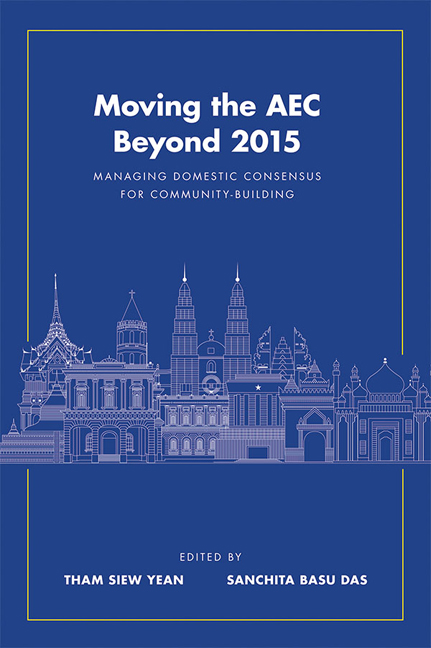Book contents
- Frontmatter
- Contents
- Foreword
- Preface
- Acknowledgements
- Abbreviations
- About the Contributors
- 1 Introduction: Economic Interests and the ASEAN Economic Community
- 2 ASEAN Economic Cooperation and Its Political Realities
- 3 Indonesia's Implementation of Facilitation and Harmonization Measures under the AEC
- 4 The AEC and Domestic Challenges in Malaysia: Examining the Liberalization of Services in AFAS
- 5 The Philippines and the AEC Beyond 2015: Managing Domestic Challenges
- 6 The AEC Beyond 2015: Implementation and Challenges for Singapore
- 7 Moving the AEC Beyond 2015: Managing Domestic Economic Interests in Thailand
- 8 Managing Domestic Consensus for ASEAN Community Building in Vietnam
- Index
8 - Managing Domestic Consensus for ASEAN Community Building in Vietnam
Published online by Cambridge University Press: 06 January 2018
- Frontmatter
- Contents
- Foreword
- Preface
- Acknowledgements
- Abbreviations
- About the Contributors
- 1 Introduction: Economic Interests and the ASEAN Economic Community
- 2 ASEAN Economic Cooperation and Its Political Realities
- 3 Indonesia's Implementation of Facilitation and Harmonization Measures under the AEC
- 4 The AEC and Domestic Challenges in Malaysia: Examining the Liberalization of Services in AFAS
- 5 The Philippines and the AEC Beyond 2015: Managing Domestic Challenges
- 6 The AEC Beyond 2015: Implementation and Challenges for Singapore
- 7 Moving the AEC Beyond 2015: Managing Domestic Economic Interests in Thailand
- 8 Managing Domestic Consensus for ASEAN Community Building in Vietnam
- Index
Summary
INTRODUCTION
Until 1986, Vietnam remained an autarky under a central planning regime with some of the following key characteristics: (i) state or collective ownership of all production means, including those in agriculture; (ii) government administered supply of physical input and output; (iii) the absence of factor markets; (iv) and highly regulated goods and services markets. Poor incentives and restricted information flows led to heavy distortions in resource allocation (Vo and Nguyen 2006). While ensuring the contribution of output to the state, cooperatives usually failed to meet half their members’ demands. Facing an economic crisis and severe food shortages, Vietnam carried out reforms in the early 1980s, but only at the micro-level.
The year 1986 marked a major breakthrough in economic reforms as the country rejected the rationale of the central planning model, and declared its intention to transform itself into a mixed-market economy. Since then, various market-oriented reforms have been undertaken, aimed at stabilizing and opening up the economy, and expanding freedom of choice for all economic units. Reforms of goods markets and factors of production took place gradually; legal and policy reforms were undertaken to create a level playing field for all economic entities, irrespective of their nationality or form of ownership.
The reforms brought about remarkable socio-economic success in Vietnam. The pace of economic growth increased steadily, averaging 7.8 per cent per annum during 1990–2010, despite moderating to below 6 per cent per annum during 2012–14. Exports expanded at an average annual rate of 18.8 per cent per annum during 1990 to 2014. GDP per capita improved from US$98 in 1990 to above US$1,910 in 2013, thereby helping Vietnam to become a middle-income country in 2008 (Vietnam News Daily, 14 April 2014). The poverty rate dropped sharply from 58.1 per cent in 1993 to just over 12.1 per cent in 2014.
The country's wide-ranging socio-economic success was the outcome of several factors. First, Vietnam had committed itself to bold and comprehensive reforms. After being severely challenged in 1985 by the failures of microeconomic reforms and by food scarcity, it recognized the importance of undertaking more comprehensive and consistent marketoriented reforms. Once they were initiated, these reforms gathered momentum and have now become practically irreversible. Moreover, these domestic reforms were largely inclusive and focused on benefits to people. This ensured sufficient domestic consensus for reforms and related policy adjustments.
- Type
- Chapter
- Information
- Moving the AEC Beyond 2015Managing Domestic Consensus for Community-Building, pp. 179 - 200Publisher: ISEAS–Yusof Ishak InstitutePrint publication year: 2016

